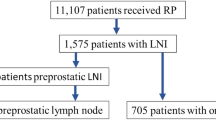Abstract
Purpose
To determine the incidence and significance of lymph nodes found in anterior prostatic fat pad (APFP) and to evaluate the risk factors for the lymph node presence at the APFP according to preoperative and postoperative characteristics during the robot-assisted radical prostatectomy (RARP).
Methods
Between January 2011 and December 2014, 100 consecutive patients (47–77) with clinically localized prostate cancer underwent APFP excision during RARP at a single institute. Extended pelvic lymph node dissection was also performed to moderate- and high-risk patients (86 patients). Preoperative and postoperative findings were recorded, and descriptive analyses and multivariable analyses to predict the presence of lymph node within APFP were performed.
Results
Lymph nodes within APFP were detected in nine (9 %) patients. None of the patients had metastatic lymph node in APFP. Preoperatively, mean PSA levels (14.22 vs. 8.6, p = 0.0001), biopsy Gleason score (p = 0.002) and radical prostatectomy pathology Gleason score (p = 0.001) were higher in patients with lymph nodes at the APFP tissue. Pelvic lymph node metastases were detected in seven of 86 (8 %) patients. Of these seven patients, four (57 %) had lymph nodes at the anterior prostatic fatty pad (p = 0.0001).
Conclusion
APFP dissection must be done regardless of the radical prostatectomy technique chosen. In our opinion, it is not necessary to do pathological examination of the APFP tissue routinely except for the patients with high preoperative PSA values, patients with high prostate biopsy Gleason scores and patients at high risk in order to save time and cost.

Similar content being viewed by others
References
Heidenreich A, Bellmunt J, Bolla M, Joniau S, Mason M, Matveev V, Mottet N, Schmid HP, van der Kwast T, Wiegel T, Zattoni F (2011) EAU guidelines on prostate cancer. Part 1: screening, diagnosis and treatment of clinically localized disease. Eur Urol 59(1):61–71
Briganti A, Blute ML, Eastham JH, Graefen M, Heidenreich A, Karnes JR, Montorsi F, Studer UE (2009) Pelvic lymph node dissection in prostate cancer. Eur Urol 55(6):1251–1256
Kim IY, Modi PK, Sadimin E, Ha YS, Kim JH, Skarecky D, Cha DY, Wambi CO, Ou YC, Yuh B, Park S, Llukani E, Albala DM, Wilson T, Ahlering T, Badani K, Ahn H, Lee DI, May M, Kim WJ, Lee DH (2013) Detailed analysis of patients with metastasis to the prostatic anterior fat pad lymph nodes: a multi-institutional study. J Urol 190:527–534
Partin AW, Mangold LA, Lamm DM (2001) Contemporary update of the prostate cancer staging nomograms (Partin tables) for the new millenium. Urology 58(6):843–848
Mottet N, Bastian PJ, Bellmunt J, van den Berg RCN, Bolla m, van Casteren NJ, Cornford P, Joniau S, Mason MD, Matveev V, van der Kwast TH, van der Poel H, Rouviere O, Wiegel J (2014) Members of the European Association of Urology (EAU) Guidelines Office. Guidelines on Prostate Cancer. In: EAU guidelines, edition presented at the EAU Annual Congress, Stockholm, pp 1–77
Tiguert R, Gheiler EL, Tefilli MV (1999) Lymph node size does not correlate with the presence of prostate cancer metastasis. Urology 53(2):367–371
Mattei A, Fuechsel FG, Bhatta Dhar N et al (2008) The template of the primary lymphatic landing sites of the prostate should be revisited: results of a multimodality mapping study. Eur Urol 53(1):118–125
Aus G, Nordenskjold K, Robinson D et al (2003) Prognostic factors and survival in node positive (N1) prostate cancer—a prospective study based on data from a Swedish population based cohort. Eur Urol 43(6):627–631
Finley DS, Deane L, Rodriquez E, Vallone J, Deshmukh S, Skarecky D, Carpenter P, Narula N, Ornstein DK, Ahlering TE (2007) Anatomic excision of anterior prostatic fat at radical prostatectomy: implications for pathologic upstaging. Urology 70(5):1000–1003
Yuh B, Huiqing W, Ruel N, Wilson T (2012) Analysis of regional lymph nodes in periprostatic fat following robot-assisted radical prostatectomy. BJU Int 109(4):603–607
McNeal JE, Redwine EA, Freiha FS et al (1988) Zonal distribution of prostatic adenocarcinoma. Correlation with histologic pattern and direction of spread. Am J Surg Pathol 12:897–906
Gleason DF, Mellinger GT (1974) Prediction of prognosis for prostatic adenocarcinoma by combined histological grading and clinical staging. J Urol 111:58–64
Clavien PA, Barkun J, de Oliveira ML, Vauthney JN, Dindo D, Schulick RD, de Santibanes E, Pekoli J, Slankamenac K, Bassi C, Graf R, Vonlahthen R, Padbury R, Cameron JL, Makuuchi M (2009) The Clavien–Dindo classification of surgical complications: five year experience. Ann Surg 250:187–196
Aning JJ, Thurairaja R, Gillatt DA, Koupparis AJ, Rowe EW, Oxley J (2014) Pathological analysis of lymph nodes in anterior prostatic fat excised at robot-assisted radical prostatectomy. J Clin Pathol 67(9):787–791
Jeong J, Choi EY, Kang DI, Ercolani M, Lee DH, Kim WJ, Kim IY (2013) Pathologic implications of prostatic anterior fat pad. Urol Oncol 31(1):63–67
Brössner C, Ringhofer H, Hernady T, Kuber W, Madersbacher S, Pycha A (2001) Lymphatic drainage of prostatic transition and peripheral zones visualized on a three-dimensional Workstation. Urology 57(2):389–393
Cellini N, Luzi S, Mantini G, Mattiucci GC, Morganti AG, Digesu C, Bavasso A, Deodato F, Smaniotto D, Valentini V (2003) Lymphatic drainage and CTV in carcinoma of the prostate. Rays 28(3):337–341
Hansen J, Budaus L, Spethmann J, Schlomm T, Salomon G, Rink M, Haese A, Steuber T, Heinzer H, Huland H, Graefen M, Michl U (2012) Assessment of rates of lymph nodes and lymph node metastases in periprostatic fat pads in a consecutive cohort treated with retropubic radical prostatectomy. Urology 80(4):877–882
Kothari PS, Scardino PT, Ohori M, Kattan MW, Wheeler TM (2001) Incidence, location, and significance of periprostatic and periseminal vesicle lymph nodes in prostate cancer. Am J Surg Pathol 25(11):1429–1514
Conflict of interest
The authors report no conflicts of interest.
Author information
Authors and Affiliations
Corresponding author
Rights and permissions
About this article
Cite this article
Ozkan, B., Tunc, B., Coskuner, E.R. et al. Role of anterior prostatic fat pad dissection for extended lymphadenectomy in prostate cancer: a non-randomized study of 100 patients. Int Urol Nephrol 47, 959–964 (2015). https://doi.org/10.1007/s11255-015-0982-4
Received:
Accepted:
Published:
Issue Date:
DOI: https://doi.org/10.1007/s11255-015-0982-4




